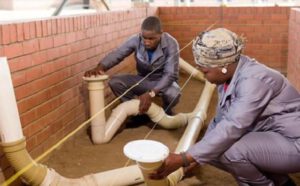Just What is Plumbing?
Plumbing is the practice of installing, altering, or repairing pipes, fixtures, and other equipment that convey fluids. It includes work related to sanitary and storm drainage systems, as well as public or private water supply systems.

Whether you are doing your own plumbing repairs or need a professional, knowing how to identify and fix problems can save you money in the long run. It’s best to have a plumber inspect your system before you make any changes or investments, especially when it comes to home additions and extensive renos.
Plumbing refers to the installation of pipes and fixtures in a home. It is an important part of residential construction and includes the distribution of water, sanitary and storm drainage systems, and appliances. Plumbers are responsible for the installation of these components as well as ensuring that they meet local codes.
It is essential for the health and safety of people to have an adequate plumbing system. This is because it can prevent the spread of disease and help protect against the spread of bacteria and other harmful organisms. It is also a cost-effective way to keep your home safe and comfortable.
When building a new home, the first step in plumbing is to set sewer accommodation stubs, which connect the home to the municipal sewerage system. The next step is to install rough-in drain fittings for sinks and bathtubs and to lay the water supply lines.
A plumbing diagram is the blueprint of all the pipes, vents, and pipe fittings that will be used for the system. This is usually drawn on a three-dimensional drawing and must be approved by the building inspector before work can begin.
In addition, you must have a plan for running the pipe through tricky areas like interior walls or beneath floors, which are generally difficult to access and may require some extra planning. If you are installing a new bathroom or kitchen, this is especially true.
One of the best aspects of plumbing is that it allows you to work in a variety of different places and environments. You can work on a variety of projects and solve problems for all kinds of clients, which means that you will always have something interesting to do.
If you are a naturally friendly person, you will enjoy the social interaction that comes with being a plumber. You will have a lot of opportunities to make house calls and spend time with your clients on a daily basis.
The industry of plumbing has been around for a long time and is a popular choice for many people. It is a rewarding career that offers a great deal of growth and opportunities for advancement.
A plumber is someone who installs and repairs appliances such as dryers, water heaters, refrigerators, ovens, dishwashers, washing machines, and more. These appliances are used to keep our homes and kitchens functioning at peak efficiency, which helps save money in the long run.
Home: The dictionary defines a home as a place where one lives, usually with their family and belongings, but the concept can also be used to refer to a person’s personal feelings. It is a place where one can feel safe and comfortable, and it is often a refuge from the outside world.
To many people, home is a place where memories are created, traditions are kept, and love is shared. It is a place of hope and comfort, regardless of one’s circumstances.
Throughout the years, a person’s perception of a home can change. To some, a home can be their greatest achievement, while others see it as just a shelter.
The word “home” is also used to describe the legal aspects of a home, including tax liability, probate law, and citizenship. Whether a person is living in the same country as their parents or moving to a new country, they can use their home to determine their legal rights and status.
Some of the skills a plumber needs include listening, troubleshooting, and understanding local codes and regulations. In addition, plumbers need to be able to work on large projects that involve the installation of plumbing systems and equipment.
Most plumbers receive their training through an apprenticeship, which combines classroom instruction with paid on-the-job training. The apprenticeship typically lasts from four to five years and consists of about 2,000 hours of on-the-job learning.
